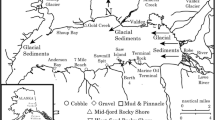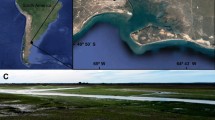Abstract
How interspecific interactions change across scales is poorly known. Such knowledge might help us understand how species interact within communities and highlight scale-dependent ecological processes in play among species. Here, I propose to analyze the inter-annual variation of a species assemblage at different ecological levels. For this, I joined a two-stage modeling approach and a spatially explicit multivariate model to analyze the interspecies relationships among six species of pelagic seabirds from 2004 to 2015 in the Barents Sea. The large-scale (~400 km) pattern of interactions revealed by the analyses suggests a change in the composition of the seabird community along the climatic gradient from south to north. At medium-scale (~300 km), the community was split into two areas (i.e., Arctic and sub-Arctic areas) suggesting niche differentiation of Arctic and sub-Arctic species driven by resource partitioning and interference competition. At a small-scale (~40 km), species with different body sizes were positively associated suggesting facilitation for accessing food although the species with the smallest body size was negatively associated with the species involved in the facilitation process suggesting interspecific interference competition. Over the years, the large-scale patterns were persistent, suggesting niche establishment, while small-scale patterns were highly variable suggesting only ephemeral interactions among species. My study demonstrates that interspecific relationships are scale-dependent and play major roles in structuring community. Untangling how species are associated with different ecological levels over time is indispensable to better understand how community structure contributes to ecological system dynamics.







Similar content being viewed by others
References
Balance LT, Pitman RL, Reilly SB (1997) Seabird community structure along a productivity gradient: importance of competition and energetic constraint. Ecology 78:1502–1518
Barrett RT (2002) Atlantic puffin Fratercula arctica and Common guillemot Uria aalge chick diet and growth as indicators of fish stocks in the Barents Sea. Mar Ecol Prog Ser 230:275–287. https://doi.org/10.3354/meps230275
Barrett RT, Asheim M, Bakken V (1997) Ecological relationships between two sympatric congeneric species, Common Murres and Thick-Billed Murres, Uria aalge and U-lomvia, breeding in the Barents Sea. Can J Zool 75:618–631. https://doi.org/10.1139/z97-077
Barry SC, Welsh AH (2002) Generalized additive modelling and zero inflated count data. Ecol Modell 157:179–188
Bellier E, Monestiez P, Certain G, Chadoeuf J, Bretagnolle V (2012) Decomposing the heterogeneity of species distributions into multiple scales: a hierarchical framework for large-count surveys. Ecography 35:839–854
Bellier E, Monestiez P, Durbec JP, Candau JN (2007) Identifying spatial relationships at multiple scales: principal coordinates of neighbour matrices (PCNM) and geostatistical approaches. Ecography 30:385–399. https://doi.org/10.1111/j.2007.0906-7590.04911.x
Bertness MD, Callaway R (1994) Positive interactions in communities. Trends Ecol Evol 9:191–193
Boitsov VD, Karsakov AL, Trofimov AG (2012) Atlantic water temperature and climate in the Barents Sea, 2000–2009. ICES J Mar Sci 69:833–840
Brown WL, Wilson EO (1956) Character displacement. Syst Zool 5:49–64
Bruno JF, Stachowicz JJ, Bertness MD (2003) Inclusion of facilitation into ecological theory. Trends Ecol Evol 18:103–109
Buckley NJ (1997) Spatial-concentration effects and the importance of local enhancement in the evolution of colonial breeding in seabirds. Am Nat 149:1091–1112
Camphuysen CJ, Webb A (1999) Multi-species feeding associations in North Sea seabirds: jointly exploiting a patchy environment. Ardea 87:177–198
Chase JM, Leibold MA (2003) Ecological Niches: Linking classical and contemporary approaches. University of Chicago, Chicago
Ciannelli L, Fauchald P, Chan KS, Agostini VN, Dingsor GE (2008) Spatial fisheries ecology: recent progress and future prospects. J Mar Syst 71:223–236
Clua E, Grosvalet F (2001) Mixed-species feeding aggregation of dolphins, large tunas and seabirds in the Azores. Aquat Living Resour 14:11–18
Connell JH (1983) On the prevalence and relative importance of interspecific competition: evidence from field experiments. Am Nat 122:661–696
Cressie N, Wikle CW (2011) Statistics for Spatio-Temporal Data. Wiley,
Cressie NAC (1993) Statistics for spatial data, revised edn. Wiley Inter-Science, New York
Davoren GK, Montevecchi WA, Anderson JT (2003) Search strategies of a pursuit-diving marine bird and the presence of prey patches. Ecol Monogr 73:463–481
Denisenko SG, Titov OV (2003) Distribution of zoobenthos and primary production of plankton in the Barents Sea. Oceanology 43:72–82
Dray S, Pelissier R, Couteron P, Fortin MJ, Legendre P, Peres-Neto PR, Bellier E, Bivand R, Blanchet FG, De Caceres M, Dufour AB, Heegaard E, Jombart T, Munoz F, Oksanen J, Thioulouse J (2012) Community ecology in the age of multivariate multiscale spatial analysis. Ecol Monogr 82:257–275
Erikstad KE, Vader W (1989) Capelin selection by Common and Brünnich's guillemots during the prelaying season. Ornis Scand 20:151–155. https://doi.org/10.2307/3676883
Evans PGH (1982) Associations between seabirds and cetaceans—a review. Mamm Rev 12:187–206. https://doi.org/10.1111/j.1365-2907.1982.tb00015.x
Fauchald P (2009) Spatial interaction between seabirds and prey: review and synthesis. Mar Ecol Prog Ser 391:139–151. https://doi.org/10.3354/meps07818
Fauchald P, Erikstad KE, Skarsfjord H (2000) Scale-dependent predator-prey interactions: the hierarchical spatial distribution of seabirds and prey. Ecology 81:773–783
Fauchald P, Mauritzen M, Gjøsæter H (2006) Density-dependent migratory waves in the marine pelagic ecosystem. Ecology 87:2915–2924
Fauchald P, Skov H, Mauritzen-Skern M, Hausner VH, Johns D, Tveraa T (2011) Scale-dependent response diversity of seabirds to prey in the North Sea. Ecology 92:228–239
Goovaerts P (1997) Geostatistics for natural resources evaluation. Oxford University Press, Oxford
Gotelli NJ, Graves GR, Rahbek C (2010) Macroecological signals of species interactions in the Danish avifauna. Proc Natl Acad Sci USA 107:5030–5035
Goulard M, Voltz M (1992) Linear coregionalisation model: tools for estimation and choice of cross-variogram matrix. Mat Geol 24:269–286
Grinnell J (1917) The niche-relationships of the California Thrasher. Auk 34:427–433
Grover JP (1997) Ressource competition. Chapman Hall, London
Grünbaum D, Veit RR (2003) Black-browed albatrosses foraging on antartic krill: density-dependence through local enhancement? Ecology 84:3265–3275
Hoffman W, Heinemann D, Wiens JA (1981) The ecology of seabird feeding flocks in Alaska. Auk 98:437–456
Ingvaldsen RB (2005) Width of the North Cape current and location of the Polar Front in the western Barents Sea. Geophys Res Lett 32:L16603
Ingvaldsen RB, Loeng H, Ottersen G, Adlandsvik B (2003) Climate variability in the Barents Sea during the 20th century with focus on the 1990s. ICES Mar Sci Symp 219:160–168
Kotliar N, Wiens J (1990) Multiples scales of patchiness and patch structure: a hierarchical framework for the study of heterogeneity. Oikos 59:253–260
Legendre P (1993) Spatial autocorrelation: trouble or new paradigm. Ecology 74:1956–1973
Levin S (1992) The problem of pattern in Ecology. Ecology 73:1943–1967
Lima SL (2002) Putting predators back into behavorial predator-prey interactions. Trends Ecol Evol 17:70–75
MacArthur RH (1972) Geographical ecology: patterns in the distribution of species. Princeton University Press, Princeton
Maestre FT, Rodrigues F, Bautista S, Cortina J, Bellot J (2005) Spatial associations and patterns of perennial vegetation in a semi-arid stepee: a multivariate geostatistic approach. Plant Ecol 179:133–147
McIntire EJB, Fajardo A (2009) Beyond description: the active and effective way to infer processes from spatial patterns. Ecology 90:46–56
Mehlum F, Gabrielsen GW (1993) The diet of high-Arctic seabirds in coastal and ice-covered, pelagic areas near the Svalbard archipelago. Polar Res 12:1–20
Monestiez P, Goulard M, Charmet G (1994) Geostatistics for spatial genetic structures: study of wild population of perennial ryegrass. Theor Appl Genet 88:33–41
Montevecchi WA, Myers RA (1996) Dietary changes of seabirds indicate shifts in pelagic food webs. Sarsia 80:313–322. https://doi.org/10.1080/00364827.1996.10413606
Nanos N, Pardo F, Nager JA, Pardos JA, Gil L (2005) Using multivariate factorial kriging for multiscale ordination: a case study. Can J For Res 35:2860–2874
Pebesma EJ, Duin RNM, Burrough PA (2005) Mapping seabird densities over the North Sea: spatially aggregated estimates and temporal changes. Environmetrics 16:573–587
Prozorkevich D, Sunnanå K (2016) Survey report from the joint Norwegian/Russian ecosystem survey in the Barents Sea and adjacent waters, August-October 2015. IMR/PINRO Jt Rep Ser 1/2016
R Development Core Team (2015) R: A language and environment for statistical computing. R Foundation for Statistical Computing, Vienna, Austria
Rahbek C, Graves GR (2001) Multiscale assessment of patterns of avian species richness. Proc Natl Acad Sci USA 98:4534–4539. https://doi.org/10.1073/pnas.071034898
Ranta E, Rita H, Lindstrom K (1993) Competition versus cooperation success of individuals foraging alone and in groups. Am Nat 142:42–58
Ricklefs RE (1987) Community diversity: relative roles of local and regional processes. Science 235:167–171. https://doi.org/10.1126/science.235.4785.167
Rosenzweig M (1995) Species diversity in space and time. Cambridge University Press, Cambridge
Schauer U, Loeng H, Rudels B, Ozhigin VK, Dieck W (2002) Atlantic Water flow through the Barents and Kara Seas. Deep Sea Res Part 1. Oceanogr Res Pap 49:2281–2298. https://doi.org/10.1016/s0967-0637(02)00125-5
Schneider DC (1989) Identifying the spatial scale of density-dependent interaction of predators with schooling fish in the southern Labrador current. J Fish Biol 35:109–115
Schoener TW (1974) Ressource partitioning in ecological communities. Science 185:27–39. https://doi.org/10.1126/science.185.4145.27
Schoener TW (1983) Field experiments on interspecific competition. Am Nat 122:240–285. https://doi.org/10.1086/284133
Shealer DA (2002) Foraging behavior and food of seabirds. In: Schreiber EA, Burger J (eds) Biology of marine birds. CRC Press, Boca Raton, pp 137–178
Sih A (1984) The behavioral response race between predator and prey. Am Nat 123:143–150
Taper ML, Case JT (1992) Coevolution among competitors. Oxford Surveys in Evolutionary Biology 8:63–109
Tasker ML, Jones PH, Dixon TJ, Blake BF (1984) Counting seabird at sea from ships: a review of methods employed and a suggestion for standardized approach. Auk 101:567–577
Tilman D (1986) A consumer-resource approach to community structure. Am Zool 26:5–22
Vilchis LI, Ballance LT, Fiedler PC (2006) Pelagic habitat of seabirds in the eastern tropical Pacific: effects of foraging ecology on habitat selection. Mar Ecol Prog Ser 315:279–292
Wackernagel H (2003) Multivariate geostatistics: an introduction with application, 3rd edn. Springer, Berlin
Webster R, Oliver MA (2007) Geostatistics for environmental scientists. Statistics in practice. Wiley, Chichester
Weimerkirsch H (2007) Are seabirds foraging for unpredictable resources? Deep Sea Res Part 2 Top Stud Oceanogr 54:211–223
Welsh AH, Cunningham RB, Donnelly CF, Lindenmayer DB (1996) Modelling the abundance of rare species: statistical models for counts with extra zeros. Ecol Modell 88:297–308
Wiens JA (1989) Spatial scaling in ecology. Funct Ecol 3:385–397
Wiens JJ (2011) The niche, biogeography and species interactions. Philos Trans R Soc Lond B Biol Sci 366:2336–2350. https://doi.org/10.1098/rstb.2011.0059
Wood SN (2006) Generalized additive models. An introduction with R. CRC, Boca Raton
Wood SN, Augustin NH (2002) GAMs with integrated model selection using penalized regression splines and applications to environmental modelling. Ecol Modell 157:157–177
Wootton JT (1994) The nature and consequences of indirect effects in ecological communities. Annu Rev Ecol Syst 25:443–466
Yaragina NA, Dolgov A (2009) Ecosystem structure and resilience—a comparison between the Norwegian and the Barents Sea. Deep Sea Res Part 2 Top Stud Oceanogr 56:2141–2153.
Acknowledgements
This study was funded by the Norwegian Research Council (WFR 185109). I am grateful of Per Fauchald to have provided data collected during the Norwegian/Russian ecosystem surveys, for his contribution to the study design and comments on earlier versions of the manuscript. I thank reviewer Courtney Admunson and two anonymous reviewers for comments that substantially ameliorate the manuscript. I thank the editor-in-chief for advice to perform the revision of the manuscript.
Author information
Authors and Affiliations
Corresponding author
Ethics declarations
Conflict of interest
The author has no conflict of interest.
Electronic supplementary material
Below is the link to the electronic supplementary material.
Rights and permissions
About this article
Cite this article
Bellier, E. Variation of interspecific interactions at different ecological levels within an assemblage of Arctic marine predators. Polar Biol 42, 99–113 (2019). https://doi.org/10.1007/s00300-018-2402-6
Received:
Revised:
Accepted:
Published:
Issue Date:
DOI: https://doi.org/10.1007/s00300-018-2402-6




